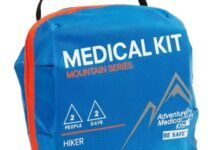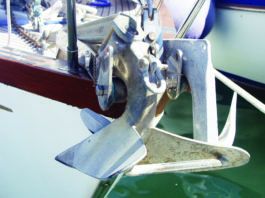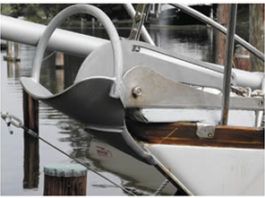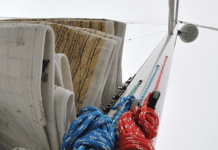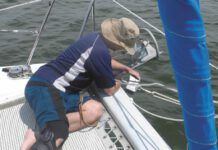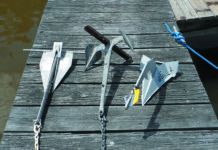Anchors Move
Nylon Rope Endurance Test
Know Your Gypsy
Mooring Chain Background
Bad Holding Ground Primer
Common Bottom Type Abbreviations
Shore Ties and Accessories for Extreme Anchorange
The lightweight anchor
THE LIGHTWEIGHT ANCHOR
All anchors are a compromise. Since some anchor types work best in certain bottoms, it is a good idea to carry anchors of different designs. At minimum, a cruising sailboat should carry at least two anchors adequately sized to anchor the boat under most conditions. Four anchors is often the norm on offshore cruising boats-two working anchors (a primary and secondary), one stern anchor or kedge, and one over-sized storm anchor-but cruising boats that sail with six or more full-sized anchors are not uncommon.
So where does a lightweight alloy anchor fit in the hierarchy of cruising anchors? It depends. Aluminum alloy anchors, particularly multi-part anchors, have a number of strikes against them. Lighter anchors take longer to set and are more likely to drag; their shanks are more vulnerable in side-load situations (aluminum alloys can shear when steel will bend); and multi-part anchors like the Fortress and Spade introduce other handicaps.
Despite these drawbacks, if Wednesday evening buoy racing is your passion, theres nothing wrong with an alloy race-day anchor. Owners of heavy-displacement boats with formidable bow rollers should look at high-tensile steel anchors for their primary anchor.
While high-tensile steel is the king of primary anchors, lightweight alloy anchors have two chief advantages-even for cruising sailors. They are portable, and they are easier to deploy by hand from a small boat. This is useful for kedging a boat into deeper water or away from a pier or obstruction.
Because alloy anchors are so easily moved around the boat, they don't need to be stowed on a dedicated bow roller, making them an appealing choice for a third, backup anchor- especially on boats with only one bow roller. Sizing an alloy anchor varies according to its purpose. Generally, the alloy anchor you choose should have similar holding capacity as the boats primary anchor.
For more advice and information on anchoring, purchase the ebook Specialty Anchors/Real World Anchoring from Practical Sailor.
Choosing an Anchor With the Appropriate Holding Power
Physical measurements of anchors cannot produce definitive conclusions about anchor performance, but they offer clues to likely performance in different conditions.
Our analysis found that the measurements (tip weight, total weight, blade area, etc.) of the tested anchors suggest that the Rocna and Manson Supreme should provide similar holding power when fully buried in a good bottom.
The Ray could have an edge in setting performance and in holding power in a common type of poor bottom (thin sand over rock/coral). One note of caution is that these measurements apply only to these particular size anchors, and scale effects may change the rank order in smaller anchors.
An anchors tip weight is the percent of the anchors total weight that the tip of the anchor puts on the sea bottom when the anchor is lying on its side. (The position the anchor normally assumes when it lands on the bottom.) This is viewed as an important factor in determining an anchors setting ability. The Ray has the heaviest tip weight of the three anchors tested.
Blade area is the surface area of the anchor blade when the anchor is completely dug in. This is considered an important factor in determining an anchors holding power. The Rocna has the largest total blade area of those anchors tested.
Tip blade area is the surface area of the first 9 inches of the blade tip. A common poor-holding bottom type has a couple inches of sand or mud over a harder rock or coral surface. According to Starzinger and Leonard, its been their experience that only the first 9 inches or so of the tip will bury in these bottoms-and often only two of the three flukes in a Bruce design-so this measurement is an indication of holding power in this sort of poor anchoring bottom. Of those tested, the Ray has the largest blade area.
For more advice and information on anchoring plus our evaluations of the anchors mentioned above, purchase the ebook Specialty Anchors/Real World Anchoring from Practical Sailor.
Hurricane Season: A season for planning
Tis the Season for Planning
The arrival of hurricane season is always a good reminder for boat owners to put together a storm plan detailing where and how the boat will be secured should a storm roll through.
Chafe protection for docking and mooring lines is essential for securing a boat ahead of a storm, but boat owners should also be sure to inspect the cleats themselves. The cleats should be beefy enough to handle the task at hand, and they should be properly supported with sturdy, easy-to-inspect backing plates. In addition to ensuring your cleats are structurally sound, its also important to pay attention to line leads. If a line must make a sharp bend at a chock or cleat, the risk of chafe increases significantly, and attaching anti-chafe gear at the bend is imperative.
Also, if your boat will be riding the storm out on a mooring, be sure to inspect the chain, swivels, and pendant on that mooring for wear. At the heart of any storm prep plan that involves anchoring is the ground tackle and how its set. PS Technical Editor Ralph Naranjo has used the following anchor combination and anchoring system with success in various locations to moor his 41-foot Ericson sloop:
A 45-pound CQR, with 10-millimeter (3/8-inch) all-chain rode, 5/8-inch nylon snubber, and leather anti-chafe gear.
A Paul Luke 75-pound, three- piece fisherman storm anchor, 50-feet of 1⁄2-inch chain, 200-feet of 3⁄4-inch nylon, leather anti-chafe gear (no swivel).
Set the two anchors at about a 60- degree angle, placing the storm anchor toward the worst of the expected wind and sea. Leave enough swinging room to cope with the likely wind shift, which could be as much as 180 degrees.
For more advice on protecting your boat and anchoring gear, purchase the ebook Anchor Rode Accessories from Practical Sailor.


























